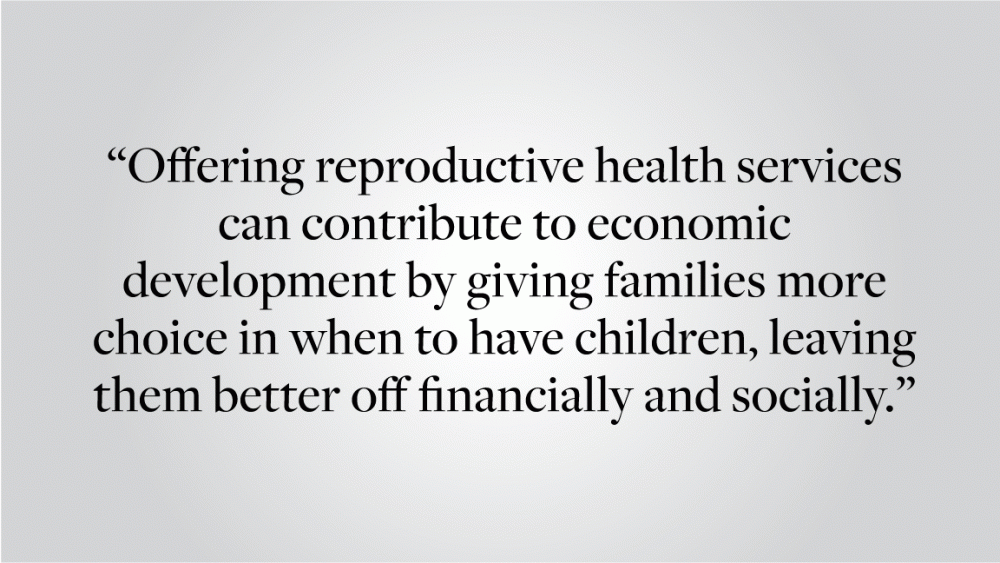Because of factors such as poverty, sexism and cultural and religious stigma, women in low-income countries often struggle to access reproductive health services. Just 59 percent of women in these nations give birth in health facilities, for instance, and 218 million of them need contraception but lack access. In this light, it makes sense that governments, policymakers and researchers in low-income countries have long asked whether the provision of reproductive health services can increase living standards and wealth in the developing world by helping women to lead happier, healthier lives.
Hoping to answer that question, NGOs and aid organizations have made the provision of reproductive health services a central part of their development agenda, finding empirical results suggesting that provision has benefits reaching far beyond just lowering fertility rates. Evidence of the link between family planning programs and fertility in developing countries is far from clear-cut. Nonetheless, offering reproductive health services can contribute to economic development by giving families more choice in when to have children, leaving them better off financially and socially.
In rich and poor countries alike, women who become mothers at an early age are often forced to give up education. But by offering contraception in poor countries, where 225 million women still lack access to birth control, governments and activists can work to ensure that women in adolescence and young adulthood are able to take full advantage of the returns to education. Stanford professor Grant Miller substantiates that claim in his study of Profamilia, which was Colombia’s “dominant family planning provider” for decades. In rural areas where family planning services were hard to come by, Profamilia filled the gaps. In cities, it democratized access to contraceptive devices, selling them at cost to drugstores. And perhaps most importantly, the organization worked to change cultural attitudes through community outreach. Because Profamilia’s expansion from district to district in Colombia was relatively random, Miller is able to estimate the impact of its services by comparing social outcomes in areas where the organization operated to those where it didn’t.
Profamila had a limited impact on lifetime fertility rates; it could only have been responsible for 6 to 7 percent of the decrease in Colombian fertility rates over the time period that Miller studies. Perhaps Colombian women had fewer and fewer children not because they finally had contraceptives, but because they were becoming richer. Indeed, the components of industrialization, including urbanization, higher levels of education and a shift away from agriculture, drastically alter the costs and benefits of procreation.
But when their impact beyond fertility rates is taken into account, Profamilia likely changed lives. Women living in districts where Profamilia operated ended up better off than those living in districts where it didn’t. They stayed in school longer than their peers and enjoyed a 4 to 7 percent increase in “the probability of formal sector employment.” These two trends suggest that even though Profamilia didn’t drastically change fertility rates, it allowed young women to postpone childbearing to get educated. While the provision of reproductive health services might not drastically reduce overall fertility rates, it can give women economic security through higher wages.
The social impacts of providing reproductive health services are especially comforting in the face of a key public health challenge: sex-based health discrepancies, which are even more pronounced in the developing world. Fortunately, family planning and reproductive health services programs can help address that inequality. The Matlab project, a massive family planning and medical services intervention in Matlab, Bangladesh, helps illuminate that link. Using data from 1977 — the first year of the program — to 1996, T. Paul Schultz and Shareen Joshi, economists at Yale and Georgetown respectively, compare a treatment group receiving the benefits of the program, to a control group receiving only limited medical support. They then evaluated differences in the fertility and health of the two groups.
Women who received the benefits of the program had, on average, one fewer child and one unit higher BMI than those who did not. For those near malnourishment, that increase in BMI could be substantial for economic productivity, not to mention general well-being. It seems, too, that healthier, less time-restricted individuals are better able to consider preventive health measures such as vaccination. And each form of preventive health care that the authors assessed was more common in the treatment group. The Matlab program went far beyond just decreasing fertility. It also made a range of women healthier and turned them into even more effective workers and mothers.
But, concerns about the Matlab program’s potential for general use of the Matlab program are valid. Joshi and Schultz themselves note that “(Over) time … additional services (beyond those related to reproductive health) were added to the program,” such as the provision of diarrheal medication. Though skeptics might argue that the study fails to isolate the causal impact of providing reproductive health services alone on economic development, Miller’s study was limited to family planning services, allowing us to more plausibly interpret his results as causal. Even if intervention beyond reproductive services enhanced welfare among Matlab recipients, evidence from Colombia reinforces the link between reproductive health services and development. Those results suggest that family planning itself gives women the chance to invest in their own education and health.
People and groups fighting to improve lives in developing countries are right to look toward family planning services — if not to lower fertility rates, then to deliver better health, give women the chance to get educated and let them live more comfortably. Aid efforts cannot afford to neglect the capacity of reproductive health services to better the realities faced by citizens. Low-income countries need these services not just so that families can choose to have fewer children, but so that they can have better lives even if they don’t.
Arjun Shanmugam ’23 can be reached at arjun_shanmugam@brown.edu. Please send responses to this opinion to letters@browndailyherald.com and op-eds to opinions@browndailyherald.com.

ADVERTISEMENT




